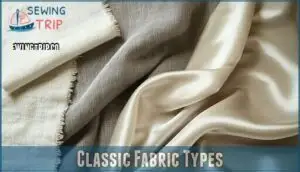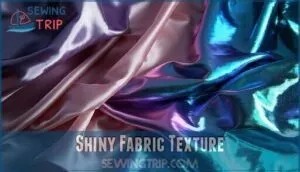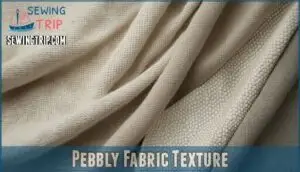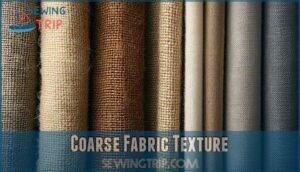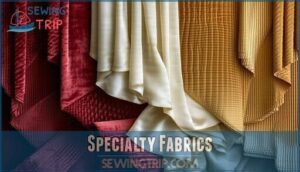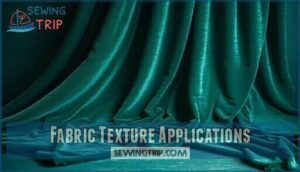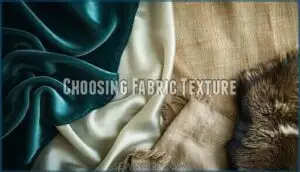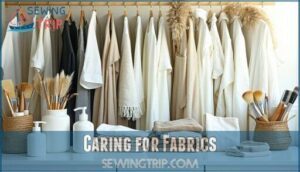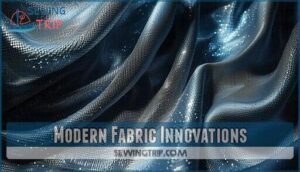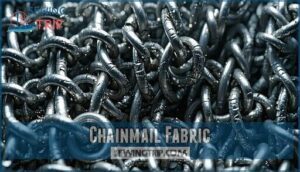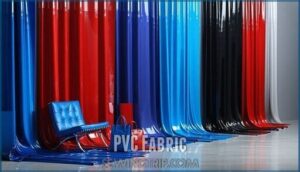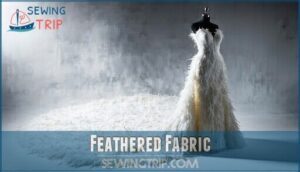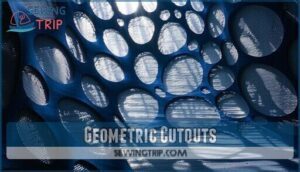This site is supported by our readers. We may earn a commission, at no cost to you, if you purchase through links.
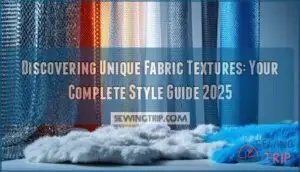
Modern fabrics push boundaries – think chainmail knits that flow like liquid metal, laser-cut geometrics that create sculptural drama, and scuba materials that bounce back from wrinkles instantly.
These aren’t your grandmother’s cotton weaves. Today’s textures combine ancient techniques with cutting-edge technology, offering everything from furry surfaces that beg to be touched to pebbly weaves that catch light beautifully.
The secret lies in matching texture with purpose – whether you need technical performance or luxurious hand-feel. Smart fabric selection can make or break your vision, and the most innovative designers know exactly which textures will elevate their work from amateur to professional-grade masterpiece.
Table Of Contents
Key Takeaways
- You’ll discover fabric texture comes from three main elements: the fibers used, how they’re woven together, and special finishing treatments that create everything from silk’s smooth surface to burlap’s rough feel.
- You can transform ordinary projects into extraordinary creations by exploring modern innovations like chainmail knits that flow like liquid metal, laser-cut geometrics that create sculptural drama, and scuba materials that bounce back from wrinkles instantly.
- You need to match texture with purpose when selecting fabrics—consider what you’re making, how eco-friendly you want to be, and how the material feels against your skin, since velvet won’t work for outdoor gear and scratchy wool isn’t great for baby clothes.
- You can maintain your textured fabrics’ beauty for years by using cool wash temperatures, skipping fabric softeners that flatten unique textures, air-drying whenever possible, and storing materials with proper humidity control and smart folding techniques.
Fabric Texture Basics
You’ll discover that fabric texture comes from three main elements: the fibers used, how they’re woven together, and special finishing treatments that create everything from silk’s smooth surface to burlap’s rough feel.
Texture transforms ordinary fabric into extraordinary experiences that speak to your senses and elevate every project.
Understanding these texture basics helps you choose fabrics that both look right and feel perfect for your specific project, whether you’re making clothes, decorating your home, or working on crafts.
History of Fabric Textures
You’ve probably never thought about it, but fabric history tells humanity’s most tactile story.
Ancient Textiles began with simple hand-weaving techniques that created both function and beauty.
Here’s how fabric texture design evolved:
- Ancient weaving produced durable patterns using natural fibers and basic looms
- Medieval Textures introduced complex tapestries and guild-controlled craftsmanship
- Renaissance Fabrics brought luxurious silks that symbolized wealth and artistic achievement
- Industrial Revolution transformed production with synthetic materials and mechanized processes
- Modern Innovations continue pushing boundaries with laser-cutting and technical advances
Importance of Fabric Texture
The right fabric texture transforms ordinary spaces into extraordinary experiences.
Texture isn’t just what you see—it’s what you feel, and how it makes you feel matters most.
Your Sensory Experience begins the moment you touch velvet’s plush surface or linen’s crisp weave.
These Fabric Tactile Sensations create powerful Emotional Connections—think childhood blankets or favorite sweaters that still bring comfort.
Texture Perception guides every Fabric Choice you make.
Smooth surfaces feel modern and sleek, while rough textures add rustic charm.
This Texture Influence shapes room moods and personal style.
Smart Fabric Texture Exploration reveals how Design Impact works.
Texture Design isn’t just about looks—it’s about creating spaces that feel as good as they appear, making every Fabric Touch and Feel meaningful.
Types of Fabric Textures
Understanding fabric texture makes all the difference in your design choices. Fabric textures fall into distinct categories that transform how textiles look, feel, and perform in your projects.
Textured fabrics offer endless possibilities:
- Rough Textures: Burlap and tweed provide sturdy, rustic appeal
- Soft Textures: Velvet and chenille create luxurious comfort
- Knit Textures: Jersey and ribbed weaves offer stretch and movement
- Woven Textures: Canvas and denim deliver durability and structure
- Novelty Textures: Sequined and embroidered fabrics add dramatic flair
These types of fabric guide your fabric texture exploration journey. When selecting materials, remember to keep in mind fabric weight in GSM for the best results.
Classic Fabric Types
You’ll find that classic fabrics like cotton, linen, wool, and satin form the foundation of most wardrobes because they’re reliable, versatile, and easy to work with.
These timeless materials offer different textures and benefits, from cotton’s breathable comfort to wool’s cozy warmth, making them perfect starting points for understanding how fabric choice affects both style and function, with classic fabrics being a key element and providing breathable comfort.
Cotton Fabric
Cotton fabric serves as your textile foundation, offering unmatched versatility through various cotton weaves that create distinctive fabric textures.
You’ll discover organic cotton provides superior softness while maintaining cotton durability that withstands daily wear.
Cotton blends enhance performance by combining natural fibers with synthetics, creating innovative fabric textures perfect for modern needs.
Cotton processing techniques reveal unique fabric patterns, from smooth percale to textured canvas.
This textile texture discovery reveals why cotton remains a cornerstone material—it’s breathable, absorbent, and adapts beautifully to countless applications in your wardrobe.
Linen Fabric
Linen fabric brings that perfect summer breeze feeling to your wardrobe.
Linen Durability means your pieces last for years, while Linen Weaves create different textures from smooth to slightly rough.
Linen Sourcing matters for quality, and Linen Blends with cotton soften the feel.
Linen Finishes can add wrinkle resistance, making this fabric texture discovery essential for unique fabric textures.
Wool Fabric
Beyond its reputation as nature’s thermostat, wool fabric delivers unmatched warmth and breathability.
You’ll discover wool textures ranging from soft merino to robust tweeds, each offering unique fabric insulation properties. Smart wool sourcing guarantees quality, while modern wool blends enhance durability and comfort.
- Wool grades determine softness and warmth levels
- Wool properties include natural moisture-wicking abilities
- Winter fabrics rely on wool’s superior insulation
- Wool alternatives offer cruelty-free options for conscious consumers
Satin Fabric
Smooth as silk and twice as enchanting, satin fabric brings that coveted shiny fabric texture to your wardrobe.
You’ll find satin weaves create this signature glossiness through a special floating technique where threads skip over each other, producing that lustrous surface we all love.
Satin variations range from traditional silk satin to modern polyester blends.
Hammered satin offers subtle texture variations, while faux satin provides budget-friendly elegance without sacrificing style.
The fabric visual texture catches light beautifully, making everything look more expensive.
Satin uses extend beyond evening wear—think luxurious bedding, elegant curtains, and sophisticated upholstery.
While pure silk satin requires gentle care, satin durability improves noticeably with synthetic blends, giving you that glamorous look for everyday pieces.
Unique Fabric Textures
You’ll discover that unique fabric textures go beyond the ordinary cotton and silk, offering surfaces that catch light, create warmth, or add unexpected dimension to your projects.
These special textures, from shiny metallics to coarse weaves, transform simple garments into statement pieces that feel as interesting as they look, with unexpected dimension.
Shiny Fabric Texture
Shiny fabric texture catches every eye with its brilliant light reflection and luxurious appeal.
These materials transform ordinary designs into show-stopping pieces through metallic sheen and iridescent effects.
- Satin: Creates smooth elegance with natural luster
- Metallic foils: Deliver ultra-reflective coating techniques
- Holographic finishes: Produce rainbow-like color shifts
- Metallic fabric: Offers durability with glamorous shine
Many designers use lightweight shiny organza for structured garments.
Care challenges include gentle washing and proper storage to maintain their stunning appearance.
Furry Fabric Texture
Softness meets style when you discover furry fabric texture. Faux fur delivers luxury without compromising animal welfare, while pile height determines your fabric’s plushness and visual impact.
Chinchilla cloth and furry blends offer versatile options for coats, throws, and accessories. The fabric nap creates depth that transforms ordinary projects into cozy masterpieces.
Faux fur emerged in the 1960s, increasing accessibility for consumers.
When cleaning fur fabrics, use gentle cycles with cold water—fabric pile needs special care to maintain its fluffy texture and prevent matting.
Pebbly Fabric Texture
While furry textures deliver plush comfort, pebbly fabric texture offers something completely different – a distinctive dimpled surface that catches light beautifully.
Pebble weave creates fascinating artistic fabric surfaces through specialized construction techniques.
Your fabric surface exploration reveals three key benefits:
- Texture durability makes it perfect for high-traffic furniture
- Tactile qualities provide satisfying grip and visual interest
- Distinctive fabric patterns work in both apparel applications and home textiles
These textured fabric effects represent exciting texture trends in fabrics for 2025’s innovative designs.
Coarse Fabric Texture
Building on smooth textures, coarse fabrics like burlap and tweed deliver unmatched burlap durability through their coarse weaves.
These materials score high on the roughness scale, creating distinct tactile perception experiences.
Canvas fabric, corduroy, and felt offer similar rugged charm for jute applications ranging from rustic home decor to sturdy bags.
Their rough-hewn character brings authentic texture that’s both practical and visually striking.
Specialty Fabrics
You’ll find specialty fabrics offer unique construction methods that create textures you can’t achieve with basic weaving techniques.
These engineered fabrics, including pre-pleated, shirred, ribbed weave, and pre-quilted options, combine traditional craftsmanship with modern manufacturing to give your projects distinctive character and professional finishing touches.
Pre-pleated Fabric
Pre-pleated fabrics revolutionize your design game with permanent folds that won’t flatten or lose their shape.
These unique fabric types showcase pleat durability through chemical and heat treatments, creating stunning fabric textures that move beautifully.
Pleating methods include machine and hand techniques, producing various pleat types like accordion, knife, and box styles.
Perfect for elegant skirts and flowing dresses, prepleated fabric offers endless design applications.
You can explore various prepleated fabric options online.
This textured fabric guide recommends gentle care instructions: lay flat, use tissue paper, and avoid heavy pressing to maintain those gorgeous pleats.
Shirred Fabric
While pre-pleated fabrics offer structured elegance, shirred fabric brings playful sophistication to your projects.
This smocked fabric uses elasticity methods and gathering variations to create unique textile surfaces that stretch and move with you. Perfect for summer dresses and flowing tops, shirring applications transform ordinary cotton into extraordinary designs through texture manipulation.
One can also explore smocking patterns and styles to further enhance fabric textures.
- Smocking techniques create permanent pleats using elastic threads for lasting shape
- Decorative fabric designs feature ruffle straps and textured patterns in various colors
- Texture techniques in textiles combine stretch with style for comfortable, fashionable garments
Ribbed Weave Fabric
Through distinctive raised ridges, ribbed weave fabrics create stunning visual depth.
Corduroy durability meets faille sheen in these versatile fabric types, while ottoman ribs add bold dimension.
You’ll love how ribbed stretch enhances comfort without sacrificing structure.
These weave variations offer endless possibilities for jackets, upholstery, and accessories.
Ribbed fabrics deliver that perfect balance between fabric texture sophistication and everyday practicality you’re seeking.
Pre-quilted Fabric
You’ll love how prequilted fabrics combine multiple layers with decorative stitching techniques to create ready-to-use materials.
These textile textures feature diamond-shaped quilting patterns that provide excellent thermal properties for winter jackets and cozy bags.
The layer composition eliminates tedious prep work, making quilted fabrics perfect for quick design applications while delivering professional-quality fabric textures.
Fabric Texture Applications
You’ll discover how fabric textures transform your projects from ordinary to extraordinary across clothing, home décor, and nursery items.
Each texture serves a specific purpose, whether you’re creating comfortable baby bedding with soft cotton or adding visual interest to furniture with rich velvet upholstery.
Clothing and Accessories
Texture and style transform ordinary clothing into statement pieces that speak volumes about your personality.
Seasonal textures let you adapt your wardrobe—think cozy wool sweaters for winter and breathable linen for summer.
Smart fabric selection considers comfort factors like breathability and movement.
Texture mixing creates visual interest:
- Velvet blazers: Add luxury to casual outfits
- Ribbed knits: Provide stretch and warmth
- Textured accessories: Complete any look perfectly
Upholstery and Home Decor
Your living room speaks volumes through upholstery fabrics and home textiles.
Choose tweed sofas for texture durability while velvet chairs add luxury.
Mix smooth curtains with ribbed cushions for pattern integration and color harmony.
Consider budget considerations when selecting home decor fabrics—affordable options still deliver style.
Stay current with style trends through textile texture innovations that transform ordinary spaces into extraordinary sanctuaries.
Baby Bedding and Nursery
Creating baby bedding sanctuaries demands thoughtful fabric choices.
Organic cotton and bamboo deliver unmatched softness ratings while meeting strict washability standards. Hypoallergenic fabrics with safe dyes protect delicate skin from irritation. Breathable textures prevent overheating during sleep.
These fabric softness champions handle frequent washing cycles beautifully. Considering hypoallergenic bedding options can further reduce allergens.
Smart parents prioritize breathable fabrics that combine comfort with peace of mind.
Choosing Fabric Texture
When you’re selecting fabric texture, you’ll need to think about three key factors: what you’re making, how eco-friendly you want to be, and how the material feels against your skin.
Think of it like picking the perfect ingredient for a recipe – velvet won’t work for outdoor gear, and scratchy wool isn’t great for baby clothes, so matching texture to purpose makes all the difference, considering the perfect ingredient.
Purpose of Use
When selecting fabric textures, your project’s specific demands should drive every decision.
Think about durability needs for high-traffic areas and aesthetic goals that match your vision. Consider the intended climate where you’ll use the fabric, plus budget constraints that keep you realistic.
Here’s what matters most for smart fabric choices:
- User comfort – prioritize soft textures for clothing and bedding
- Fabric durability – choose sturdy weaves for upholstery and outdoor use
- Fabric characteristics – match texture properties to function
- Fabric maintenance – select easy-care options for busy lifestyles
- Mood and functionality – blend style with practical home decor needs
Sustainability and Eco-friendliness
Your fabric choices reflect your environmental commitment and values.
Choose eco-friendly fibers like hemp, bamboo, or recycled fabrics made from plastic bottles.
Sustainable dyes create vibrant colors without toxic chemicals, while organic textures offer natural beauty.
Support ethical production that treats workers fairly and protects ecosystems.
These sustainable fabrics and ecofriendly textiles prove you don’t sacrifice style for conscience.
Recyclable textiles and recycled fibers transform waste into stunning materials, making fabric sustainability both practical and beautiful.
Feel and Comfort
Beyond eco-friendly choices, your skin’s sensory experience matters most.
Tactile sensations determine whether you’ll love or loathe your fabric selection. Different textures create unique comfort levels that affect your entire day.
- Silk’s smooth tactile properties glide effortlessly against sensitive skin
- Cotton’s breathability factors prevent overheating during active moments
- Velvet’s plush texture perception offers luxurious tactile comfort
- Wool’s drape and comfort provides thermal regulation while maintaining style
Caring for Fabrics
You can’t enjoy beautiful textured fabrics if they’re ruined by poor care, so understanding proper washing and storage methods keeps your materials looking their best for years.
Whether you’re handling delicate silk or sturdy tweed, each fabric type needs specific care to maintain its unique texture and appearance.
Washing and Drying
Protect your textured fabrics by following smart fabric care practices.
Choose cool wash temperatures to preserve fabric finishes and maintain textile durability. Skip fabric softeners—they can flatten unique textures.
For stain removal, blot gently with mild solutions rather than scrubbing. Air-dry whenever possible, as heat damages delicate surfaces.
To prevent damage, consider pH neutral detergents when washing.
When ironing techniques are necessary, use low heat with a pressing cloth. These maintenance requirements guarantee fabric longevity while keeping your treasured textures looking fresh and vibrant.
Storing Fabrics
Think of fabric storage as creating a sanctuary for your precious sewing materials—proper care extends fabric longevity substantially.
Controlling humidity prevents mold growth and maintains fabric thickness integrity. Smart folding techniques prevent permanent creases while maximizing space optimization in your storage area.
- Implement humidity control using silica gel packets for moisture management
- Establish a labeling system for quick identification and pest prevention
- Master folding techniques to preserve delicate textures without damage
- Create space optimization with clear bins for visibility and accessibility
Organized fabric care transforms your storage from chaotic mess into an efficient system that protects your investment.
Modern Fabric Innovations
You’ll discover how today’s fabric makers use cutting-edge technology to create materials that weren’t possible just a few years ago.
These modern innovations combine high-tech manufacturing with creative design, giving you fabrics that stretch, shine, and perform in ways that traditional textiles simply can’t match, using modern innovations.
Technical Knits
Revolutionary technical knits transform how you experience fabric textures. These engineered performance fabrics deliver moisture-wicking properties, breathability, and stretch for activewear applications.
Material innovation creates knit structures that adapt to your body’s movements while maintaining shape.
| Property | Technical Benefit |
|---|---|
| Moisture Management | Keeps you dry during workouts |
| Stretch Recovery | Returns to original shape |
| Durability | Withstands repeated washing |
| Breathability | Allows air circulation |
| Comfort | Soft against skin |
Durability factors include fiber quality and construction methods. Knit fabrics like interlock and jersey showcase textile textures that feel luxurious yet perform under pressure.
Future innovations promise even smarter fabrics that respond to temperature changes.
Laser-Cut Fabrics
Moving from technical knits, laser-cut fabrics revolutionize pattern precision and edge finishing.
These distinct fabric materials use CO2 lasers to create geometric cutouts with sealed edges that prevent fraying. You’ll discover unique fabric textures through industrial applications that transform ordinary materials into extraordinary designs.
Here’s what makes lasercut fabrics exceptional:
- Perfect cuts with minimal heat-affected zones
- Custom patterns impossible with traditional cutting
- Enhanced durability through heat-welded edges
- Design complexity limited only by imagination
- Material choices spanning cotton to polyester silk
Scuba Fabric
Discovering unique fabric textures leads you to scuba fabric, a game-changer in modern fabric textures.
This polyester-spandex blend delivers unmatched structure and stretch, making it perfect for contemporary designs.
Originally created for diving suits, it’s now essential for fashion-forward projects.
Scuba Properties make it water-resistant and durable:
- Design Applications: Bodycon dresses, structured skirts, sportswear
- Sewing Scuba: Cuts cleanly, won’t fray or roll
- Scuba Alternatives: Neoprene, ponte knits, technical fabrics
- Future Trends: Smart textiles, eco-friendly versions
- Textile Textures: Smooth surface with substantial weight
Foiled Fabric
When you’re exploring foiled fabric, you’ll discover metallic finishes that transform ordinary textiles into showstoppers.
These specialty fabrics use advanced application techniques like heat-pressing foil onto base materials.
While durability concerns exist with washing, their stunning design aesthetics make them perfect for costumes and evening wear.
As textile innovation evolves, future trends promise even more dazzling decorative fabrics with improved longevity.
Understanding how a fabric falls is essential, as fabric drape affects the final design.
Advanced Fabric Textures
You’re about to explore fabrics that push creative boundaries with materials like chainmail, PVC, feathers, and geometric cutouts.
These advanced textures transform ordinary designs into bold fashion statements that demand attention and showcase your unique style vision.
Chainmail Fabric
Chainmail fabric brings medieval armor into modern fashion with remarkable Chainmail Durability and flexibility.
This specialty fabric’s metal mesh construction creates stunning visual appeal while maintaining Chainmail Comfort for extended wear.
Here’s what makes chainmail fabric extraordinary:
- Historical Accuracy – Authentic techniques dating back to 4th century B.C.E.
- Modern Applications – Fashion accessories, costumes, and protective gear
- Production Methods – Small metal rings individually linked for flexibility
- Textile Textures – Unique metallic finish unavailable in woven textiles
- Versatility – Lightweight versions perfect for contemporary designs
PVC Fabric
PVC fabric delivers that unmistakable glossy finish you’ve been craving. This synthetic textile champion excels in wet conditions while maintaining its sleek appearance through countless adventures.
- PVC Applications: Rain gear, trendy handbags, and statement furniture pieces
- PVC Finishes: Mirror-like gloss to subtle matte textures
- PVC Sustainability: Explore bio-based alternatives for eco-conscious fabric choices
PVC Durability makes it perfect for high-traffic textile materials needing serious staying power.
Feathered Fabric
While PVC offers synthetic shine, feathered fabric brings organic elegance to your creative textile textures.
You’ll find this luxurious material perfect for evening gowns and theatrical costumes.
Feather sourcing requires attention to ethical concerns—choose suppliers who guarantee cruelty-free harvesting.
Application ideas range from accent trims to full garment coverage.
| Design Challenges | Cleaning Methods | Fabric Identification |
|---|---|---|
| Shedding control | Gentle hand washing | Natural vs. synthetic |
| Weight distribution | Air drying only | Feather density check |
| Attachment security | Spot cleaning preferred | Base fabric type |
| Movement flexibility | Professional cleaning | Adhesive quality |
| Cost considerations | Storage in breathable bags | Color fastness test |
Custom fabric textures using feathers create textile design inspiration that’s both dramatic and delicate.
Geometric Cutouts
Geometric pattern innovation transforms ordinary fabrics into architectural masterpieces through laser precision technology.
You’ll discover cutout design possibilities that create stunning layered effects and dramatic silhouette creation.
These textile design inspiration pieces showcase visual texture like never before, with patterned fabrics featuring intricate openwork that plays beautifully with light and shadow.
- Laser precision guarantees clean, fray-free edges for complex geometric patterns
- Layered effects create depth when fabrics overlap or layer beneath cutouts
- Silhouette creation transforms garments into wearable art pieces
Frequently Asked Questions (FAQs)
How to identify different types of fabrics?
Run your fingers across the surface—smooth silk whispers luxury while rough burlap shouts rustic charm.
You’ll identify fabrics by examining their weave patterns, fiber content, texture, drape, and how they respond to light and touch.
What is the rarest fabric?
You’ll find vicuña wool stands as the world’s rarest fabric.
This luxurious fiber comes from South American vicuñas, whose fleece can only be harvested every three years, making it incredibly precious and expensive.
What are the different textures of fabric?
Fabric textures range from smooth silk and soft velvet to rough burlap and coarse tweed.
You’ll find ribbed knits, crinkled crepe, plush chenille, delicate lace, and absorbent terrycloth – each offering unique tactile sensations for different applications, with unique textures.
How can you tell different fabrics apart?
Touch reveals everything – silk feels smooth and cool, wool’s rough and warm, cotton’s soft yet sturdy.
Look closely at weave patterns, check fabric weight, and notice how light reflects differently across each material’s unique surface texture, which can also reveal the texture.
What is the rarest type of fabric?
Vicuña wool claims the crown as the world’s rarest fabric.
You’ll find this luxurious material costs thousands per yard because vicuñas can’t be domesticated and only produce tiny amounts annually.
What is the most unique fabric in the world?
Ironically, you’ll find spider silk—nature’s strongest fiber—remains largely theoretical for commercial use.
Biosteel, genetically engineered from goat milk proteins, mimics this extraordinary material, creating bulletproof vests and surgical sutures with unmatched strength-to-weight ratios.
What determines fabric texture?
Three main factors shape how fabric feels beneath your fingertips: the fiber type you’re working with, the weaving or knitting technique used, and any special finishing processes applied during manufacturing.
What are the different types of textured fabrics?
You’ll find amazing variety in textured fabrics like soft chenille, rough burlap, luxurious velvet, crinkled crepe, and absorbent terrycloth.
Each offers unique tactile experiences through different fibers, weaving techniques, and finishing processes, providing a range of sensations from soft chenille to rough burlap.
What is a texture fabric?
Textured fabric has an irregular, uneven surface that you can feel when you touch it.
Unlike smooth materials, it’s created through special fibers, weaving techniques, or finishes that add tactile dimension and visual interest.
Why is textured fabric important?
You’ll discover textured fabrics transform ordinary designs into enchanting experiences.
They add visual depth, tactile comfort, and emotional connection while enhancing durability.
These fabrics elevate style, create mood, and make your projects memorable through sensory appeal.
Conclusion
Mastering the art of discovering unique fabric textures isn’t rocket science – it’s pure creative magic waiting to transform your next project.
You’ve now got the complete roadmap to navigate everything from chainmail knits to laser-cut geometrics.
Whether you’re crafting couture garments or revitalizing your home decor, these innovative textures will elevate your work from ordinary to absolutely extraordinary.
Remember, the perfect texture match can make your creative vision sing.
Start experimenting today and watch your projects come alive with creative magic.
- https://searchforfabric.com/blogs/search-for-fabric-blog/the-unique-qualities-of-sheen-fabric
- https://www.masterclass.com/articles/what-is-satin-fabric-a-guide-to-the-types-characteristics-and-uses-for-satin
- https://www.bridgetteraes.com/2020/12/02/texture-and-shine-why-shiny-fabrics-might-not-work-for-you
- https://icefabrics.com/blogs/news/guide-about-satin-fabric
- https://textilementor.com/role-fabric-texture-in-textile-interior-design

